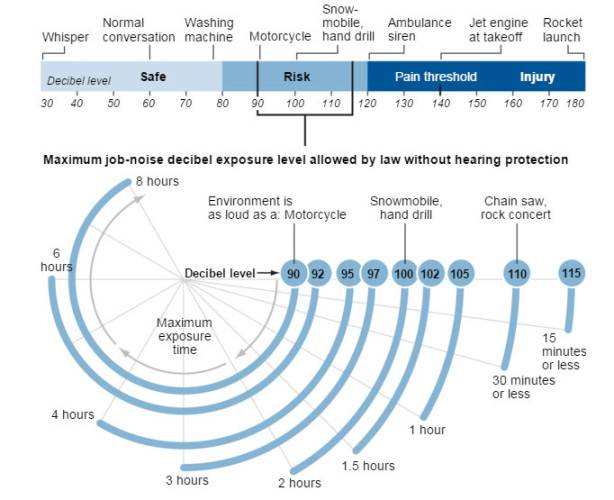Jemal R. Brinson
Original Article
People have listened to loud music for as long as there has been music. But the spread of smartphones with built-in music players along with the earbuds that come with them could be compounding the problem, especially for young people.
The numbers show it. A 2015 World Health Organization report found that nearly 50 percent of teens and young adults ages 12-35 are exposed to unsafe levels of sound from their personal music players. A 2010 Journal of the American Medical Association analysis found a significant increase in young people with hearing loss from three decades ago.
These trends are very much connected, according to James Foy, an osteopathic physician and professor of pediatrics at Touro University near San Francisco and an expert on hearing loss in children.
Which leads to the question, how loud is too loud?
Sound is measured in units called decibels. Generally, levels of 75 decibels or less are considered safe and won’t cause hearing damage, according to National Institute on Deafness and Other Communication Disorders. Headphones and earbuds can emit a maximum sound from 85 to 110 decibels, levels that could lead to hearing loss, Foy said.
Foy recommends following the “60/60 rule.” If your device has a volume range of 1 to 10, the highest listening level should be no more than 60 percent of the volume range. Listening should also be limited to 60 minutes per session.
A more simple way to tell: If you can’t hear conversations around you, Foy said, your music is probably too loud.
How people hear normally
1. Sound enters: Sound waves pass through the outer ear down the ear canal to the eardrum. The eardrum vibrates and sends those vibrations to three bones in the middle ear called the hammer, anvil and stirrup.
2. Processing the sound: Vibrations from the hammer, anvil and stirrup form waves in the fluid-filled cochlea. The cochlea has a partition called the basilar membrane that is covered by sensory hair cells.
3. Riding the wave: Waves move the hair cells up and down. Microscopic cilia bend and allow chemicals to rush into the cell, which creates an electrical signal.
4. Auditory nerve: The electrical signal is sent to the brain along the auditory nerve, which converts the signal into recognizable sound.
Over-the-ear or in-ear? Which headphones to choose
Foy said he suggests using a looser-style headphone that rests over the ear instead of earphones that are placed directly in the ear.
Over-the-ear: This type of headphone is padded and has cups that fit around the ear, keeping the speaker farther from the eardrum. The noise-canceling type eliminates outside noise, potentially limiting volume.

In-ear: Earbuds rest about 1/2 inch from the eardrum and form a tighter seal with the ear canal than earphones. Both of those factors are problematic, since they can increase the intensity of sound that is delivered to the ear, Foy said.

Measuring sound: What levels are safe
A key benchmark for hearing safety is avoiding noise levels louder than 80 decibels. High levels of noise exposure, even for a short period of time, can be harmful. Here are some examples of common sounds.

Hearing loss: What to look for
- Ringing, roaring, hissing or buzzing in the ear
- Understanding speech is difficult in noisy places or with poor acoustics
- Experiencing muffled sounds or feeling like your ear is plugged
- Having the TV or radio at higher volume levels than normal
Sources: James Foy, World Health Organization, Journal of American Medical Association, Mayo Clinic, American Osteopathic Association, National Institute on Deafness and Other Communication Disorders
Copyright © 2016, Chicago Tribune
